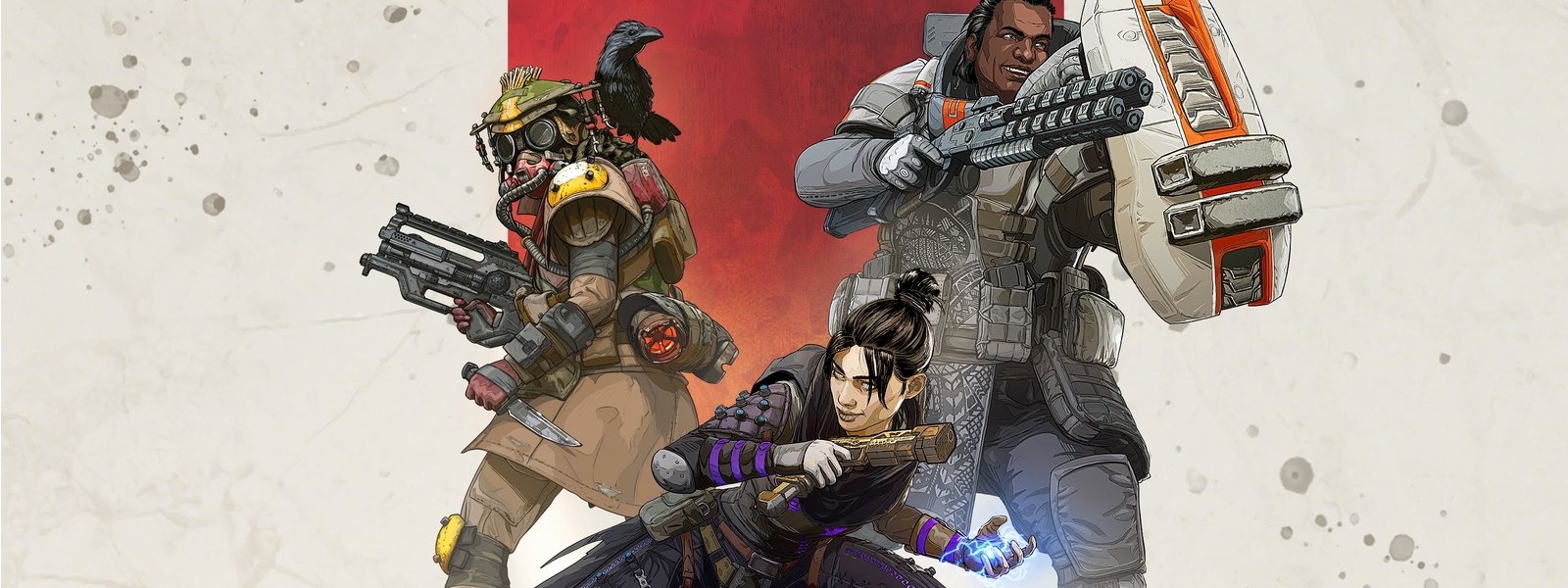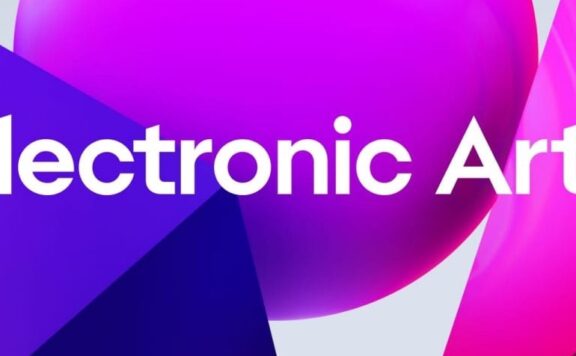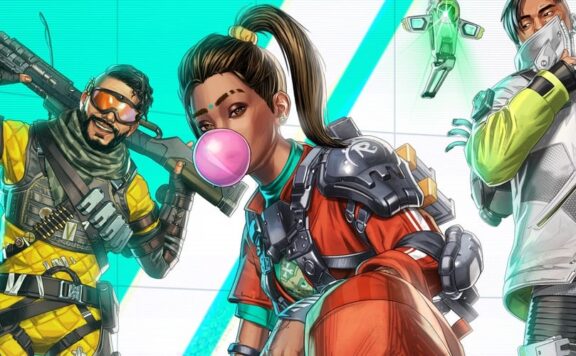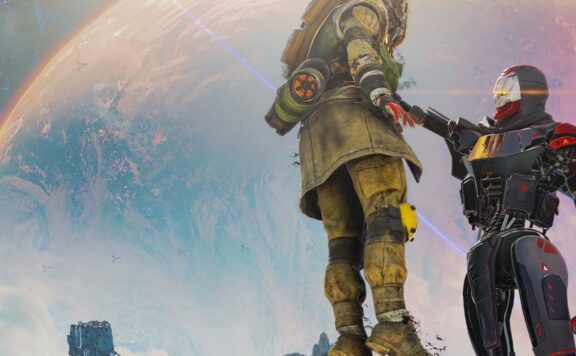Apex Legends is not the game people wanted from Respawn. With multiple teams at the studio, one working on Star Wars and one on a mystery VR game, many people expected and hoped that Respawn’s third team were working on Titanfall 3. They weren’t. They’ve found themselves instead wading into the choppy waters of Battle Royale online shooters, but thankfully came up with something that not only feels polished, but takes the genre and refines some of its more awkward aspects while retaining an identity of its own.
Apex Legends has been announced and released today as a free to play game for PS4, Xbox One and PC. Though it doesn’t carry the Titanfall brand, it’s set in the same universe as those games, just without any Titans doing any falling. It’s thirty years after the end of Titanfall 2, and somewhere away from the war between the IMC and the Frontier Militia in The Outlands, there’s Apex Legends blood sport in which contestants battle to grow their own legend.
But there’s no ‘solo’ in ‘squad’, and this game is all about playing in a squad of three. There’s no solo queue, no duos, no quads, just trios. This is where Respawn have had the biggest impact on the Battle Royale, in really focussing so purely on squad play and refining the gameplay around it.
It starts from the moment you drop, with one of the three being a designated Jumpmaster. There’s no more frantically pinging the map, no more counting from three over voice chat, and no more getting split up and lost from the group unless you actively want to do your own thing. The Jumpmaster decides when to go, and the other two players are locked in to follow as they drop, though you can hold a button to split off if you really want to. It’s such a simple sounding thing, but nobody else is doing it in this space.

Playing as a trio also works well, even if you’ve simply been bundled together through matchmaking and don’t have a headset, thanks to the ingenious Smart Comms system. Instead of a basic pinged location, if you’re looking at an enemy, the game automatically notes them as an enemy for your teammates, if you’re looting, you can highlight a gun, attachment or armour and it’s clearly recognised with a line of dialogue and a neat UI element to show what and where it is. Better yet, you can call dibs on something that’s been called out and say thanks when you pick it up. It makes working as a team effortless without voice chat, but it’s almost as transformative when you are chatting to your mates and means that you no longer have to try and awkwardly call out compass directions.
But what if one of you is downed? An age old problem with squad play in a Battle Royale is that one or two of you are knocked out the match, and then twiddle your thumbs unless your teammates are nice enough to check out with you. While you have a window in which you can revive a buddy, if they fully die, you can still try and get to their dropped box and collect their calling card. Bring that card to a respawn beacon and they will get airlifted back into the action, though they drop with no gear and the appearance of a drop ship is a huge giveaway for your location.
They’re just a few of the seemingly small refinements that Respawn have made to the formula, but they have an outsized effect on the way the game feels to play. You end up sticking together much better as a squad, you end up working together more efficiently and you’re given more reasons to stick around and cheer on your buddies if you are killed in action.

But there are still some elements that make it easy to brand this as a derivative knockoff, despite its unique elements. Unfortunately, the loss of Titans also comes with a shift away from the fast paced double jumping, wall running action of Titanfall, though this is much less relevant on a big map with lots of open spaces. You also have a much, much longer time to kill, especially when factoring in the ability to heal up and grab both body armour and helmets of various strengths – the coloured flashes as you land bullets do help to give visual feedback of what you’re dealing with, though.
The longer TTK does work, though. It’s not too long, it means that many encounters will have you reloading once when one-on-one, and that means there’s time to escape, to turn the fight back around even if you were caught napping. It also allows for breathing room with the different characters and their tactical and ultimate abilities.
Respawn are keen to stress that these aren’t characters or heroes in the vein of Overwatch, but more subtle twist that help ensure the game is still a relatively level playing field – this reasoning also allows them to lock two of them away behind play time unlocks and/or microtransactions. There’s eight to choose from, each with a particular style and with abilities that are reminiscent of Titanfall’s loadout perks. Bloodhound, for example, can ping his immediate area to check for enemies or, for his ultimate, enter Vision of the Beast to track footsteps. Wraith can step into the void and return to reality at a different location nearby, and create two connected portals for others to pass through. Lifeline is the healer, Pathfinder has a grappling hook, and so on.

As a round starts, your squad takes it in turns to pick a character, meaning you can decide on a particular team makeup, perhaps with loose healer, tank and support roles. All of them are relatively easy to pick up and play, their abilities good in a certain situations, but no match for solid gunplay and with some interesting depths and layers. Wraith can step into the a void dimension for a few moments, making her great for a quick escape, but her ultimate ability’s portals are difficult to place in useful positions. Making use of her and learning how to combine with other characters can be a big advantage.
As with any free to play game, there’s a few questions over how Respawn are handling microtransactions to make money from the game. It’s an odd hybrid mish-mash of things, that’s benign but could court controversy. There’s a now standard Battle Pass, direct purchases for cosmetics, and loot boxes that can be earnt or bought, but where odds are published and you cannot receive duplicates. You also have two of the eight launch characters locked off until you earn or buy them, effectively borrowing from the Rainbow Six model. It’s a little unnecessarily convoluted.
Honestly, Apex Legends feels like it might have an uphill struggle to gain the audience that it needs, but with Respawn’s name attached to this and the fact that they’ve now released a fleshed out, polished, finished game, I’m hopeful that it can succeed. In one fell swoop, they show just how much other examples of the Battle Royale miss out on when it comes to squad play and working as a team.
Our advanced time with Apex Legends came at an event in Los Angeles last week. Travel and accommodation were provided by EA.






gernboes
“Playing as a trio also works well, even if you’ve simply been bundled together through matchmaking and don’t have, thanks to the ingenious Smart Comms system.”
Dont have what?
Stefan L
A headset. Fixed!